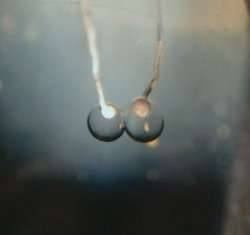Sensing light with 'liquid Lego'

Scientists at Oxford University and Duke University in the United States have used tiny water droplets to build a unique microscopic light sensor.
Their approach turns water droplets into protocells: empty artificial cells that can be filled with different cellular components. In theory, networks of protocells could be used to simulate biological systems – such as heart muscle or brain tissue.
“Each millimetre-sized water droplet in our network acts as a protocell. Chains of droplets are put together like liquid Lego, and are just as easily taken apart or reorganised,” said Dr Matthew Holden of Oxford University’s Department of Chemistry who conducted the research with Oxford’s Professor Hagan Bayley and Professor David Needham at Duke University.
The scientists took a protein (bacteriorhodopsin) normally used by bacteria to produce energy and incorporated it into a network of droplets. This protein reacts to green light by pumping protons across a cell membrane, which creates a positive electrical charge. By piercing the droplets with hair-thin electrodes this current can be measured with a sensitive amplifier. In the future such droplets could be arranged to form ‘pixels’ in an imaging array – acting as an artificial eye.
‘Using protocells to simulate biological systems offers significant advantages to working with live cells, where there is far less control over their contents, size and function,’ said Dr Holden. ‘Many living cells do not survive outside a narrow temperature range and are extremely sensitive to environmental conditions, such as pH. In the long run protocell-based systems could reduce the cost and complexity of biological experiments and, in some cases, might be used in place of animal testing.’
Although protocells have provided biological and evolutionary insights before this is the first time they have been shown working together to perform a function. The researchers hope to create increasingly complex systems as a stepping-stone towards understanding a variety of biological functions ranging from nerve impulses to heartbeats.
A report of the research is published in the Journal of the American Chemical Society.
Source: University of Oxford


















